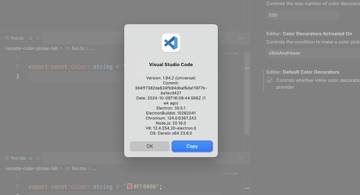Overview
Let’s talk about React.js!
- Last time: (2024-10-08) My React.js Starter Kit

Well, of course, Python is my mother tongue and the ultimate language, right? (again)
But when I set up React.js last time, it was so much fun that I decided to add i18n (multilingual support) to the starter kit from the last post!
This time, we’ll:
- Introduce the translation extensions
i18nextandreact-i18next - Add
i18next-parserto make creating translation files more efficient
Let’s get started!
Introducing the Translation Extensions
As always, I’ll put the configuration right here to keep things self-contained in my notes... but if you want to do it properly, you can just follow the official Quick Start guide below:
- Official documentation: https://react.i18next.com/guides/quick-start
# i18next: An internationalization library. The engine. You can use it with plain JavaScript.
# react-i18next: A library to integrate the above into React.
yarn add i18next react-i18next
Let’s prepare the translation json files.
mkdir -p ./src/locales/en
mkdir -p ./src/locales/ja
echo '{}' > ./src/locales/en/translation.json
echo '{}' > ./src/locales/ja/translation.json
Then, prepare the file to load and configure the translation json files.
mkdir -p ./src/i18n
echo "
import EN_TRANSLATION from '@/locales/en/translation.json'
import JA_TRANSLATION from '@/locales/ja/translation.json'
import i18n from 'i18next'
import { initReactI18next } from 'react-i18next'
const resources = {
ja: {
translation: JA_TRANSLATION,
},
en: {
translation: EN_TRANSLATION,
},
}
i18n
.use(initReactI18next)
.init({
resources,
lng: 'en',
interpolation: {
escapeValue: false
}
})
export default i18n
" > ./src/i18n/index.ts
In the entry point of the React app (main.tsx), load the configuration file.
echo "
import App from '@/App'
import '@/i18n'
import '@/index.css'
import React from 'react'
import ReactDOM from 'react-dom/client'
import { BrowserRouter } from 'react-router-dom'
ReactDOM.createRoot(document.getElementById('root')!).render(
<React.StrictMode>
<BrowserRouter basename='/my-react'>
<App />
</BrowserRouter>
</React.StrictMode>
)
" > ./src/main.tsx
Using the Translation Extension
Here’s how to use useTranslation and t. The translation json files are still empty, but when that’s the case, the key will be displayed as-is. No problem! I noticed that reference sites often use unique key strings for translations, but in the json files, you can actually use Japanese as keys. I think that’s totally fine, since it makes the components more readable!
echo "
import Button from '@/components/Button'
import formatDate from '@/utils/formatDate'
import { useEffect, useState } from 'react'
import { useTranslation } from 'react-i18next'
function HomePage() {
const { t } = useTranslation()
const [formattedDate, setFormattedDate] = useState<string>('')
useEffect(() => {
const currentDate = new Date()
const dateStr = formatDate(currentDate)
setFormattedDate(dateStr)
}, [])
const handleClick = () => {
alert(t('Button がクリックされた!'))
}
return (
<div>
<h1>{t('Welcome to the Home Page')} - {formattedDate}</h1>
<Button label={t('Click Me')} onClick={handleClick} />
</div>
)
}
export default HomePage
" > ./src/pages/HomePage.tsx
Introducing a Tool to Automatically Fill Translation json Files
This tool scans the t function in your components and automatically fills in the translation json files for you. Using this tool, you can work like this:
- Write all the strings in the components using
t - Run the tool
- The json file will be filled with combinations like
text to translate: initial value - Then, just open the json file and translate all the “text to translate” entries one by one
Super easy, right?
yarn add --dev i18next-parser
Let’s add the configuration file below. There are more detailed settings in the official README, so it might be a good idea to copy those for future reference.
- Official README: https://github.com/i18next/i18next-parser?tab=readme-ov-file#options
echo "
export default {
contextSeparator: '_',
createOldCatalogs: true,
defaultNamespace: 'translation',
defaultValue: (locale, namespace, key) => {
return \`\${key}\` // This is a change from the default setting.
},
indentation: 2,
keepRemoved: false,
keySeparator: '.',
lexers: {
hbs: ['HandlebarsLexer'],
handlebars: ['HandlebarsLexer'],
htm: ['HTMLLexer'],
html: ['HTMLLexer'],
mjs: ['JavascriptLexer'],
js: ['JavascriptLexer'],
ts: ['JavascriptLexer'],
jsx: ['JsxLexer'],
tsx: ['JsxLexer'],
default: ['JavascriptLexer'],
},
lineEnding: 'auto',
locales: ['ja', 'en'], // This is a change from the default setting.
namespaceSeparator: ':',
output: 'src/locales/\$LOCALE/\$NAMESPACE.json', // This is a change from the default setting.
pluralSeparator: '_',
input: undefined,
sort: false,
verbose: false,
failOnWarnings: false,
failOnUpdate: false,
customValueTemplate: null,
resetDefaultValueLocale: null,
i18nextOptions: null,
yamlOptions: null,
}
" > ./i18next-parser.config.js
Run this command:
yarn run i18next "./src/App.tsx" "./src/**/*.tsx"
# If you're worried that the config isn’t being loaded, try this↓
yarn run i18next "./src/App.tsx" "./src/**/*.tsx" --config "./i18next-parser.config.js"
And voilà, the translation json files will be filled up like magic. Ahh, efficiency!
{
"Welcome to the Home Page": "Welcome to the Home Page",
"Click Me": "Click Me",
"Button がクリックされた!": "Button がクリックされた!"
}





